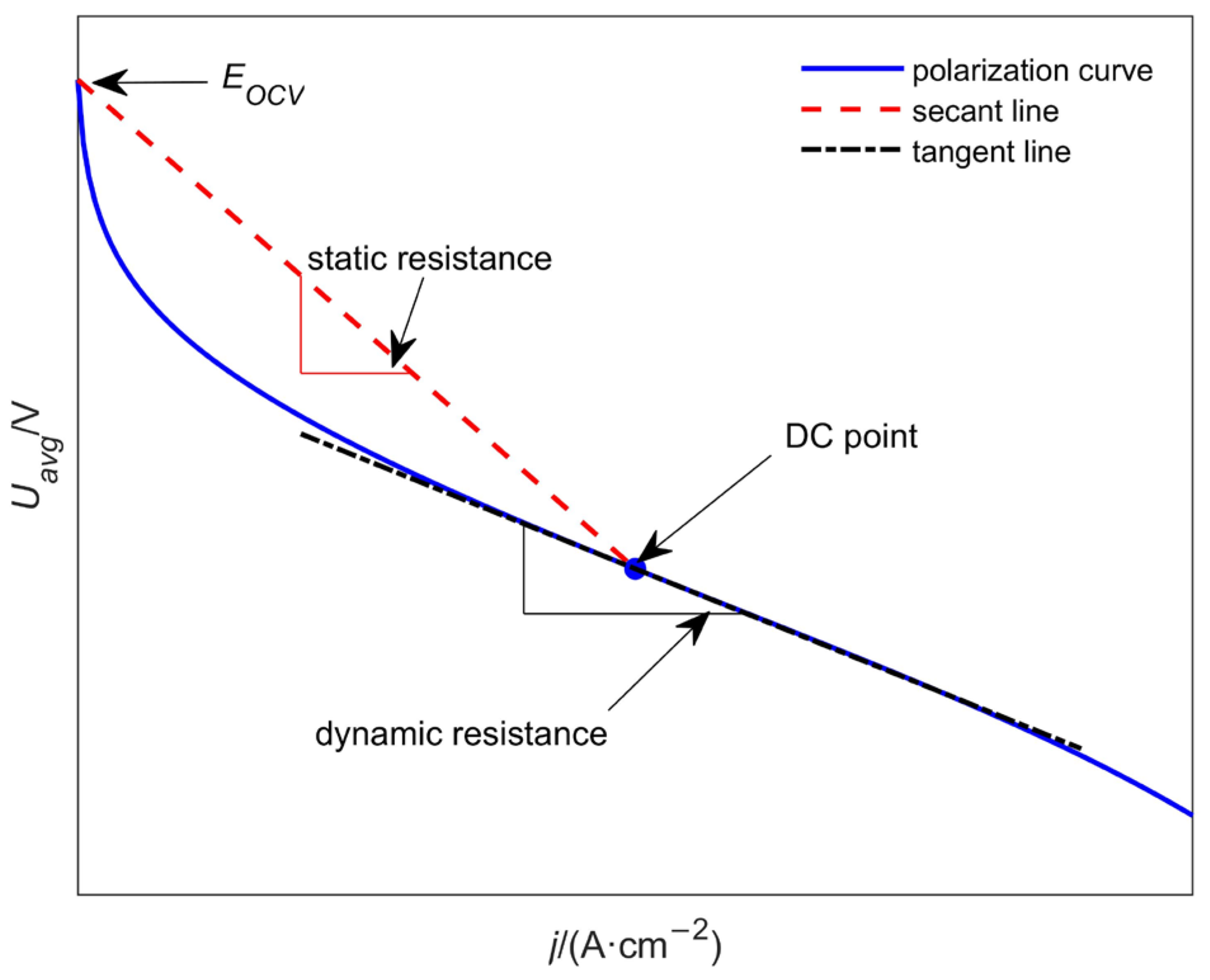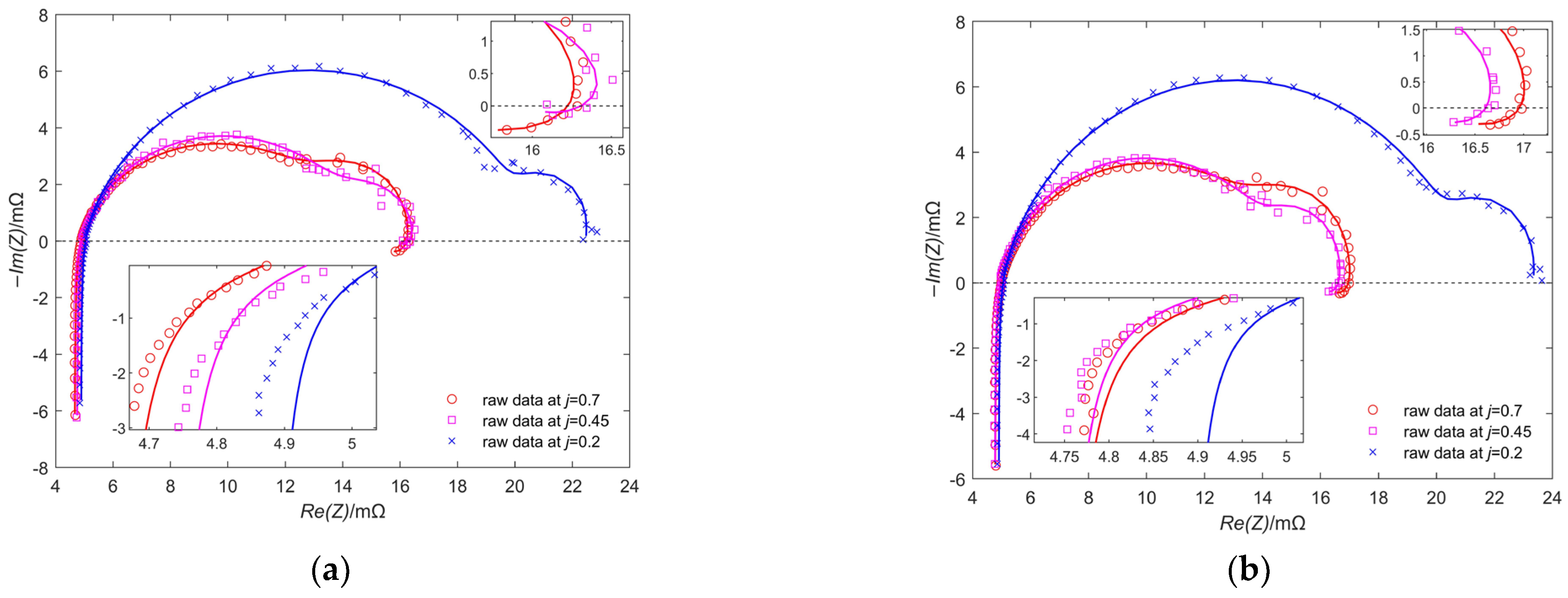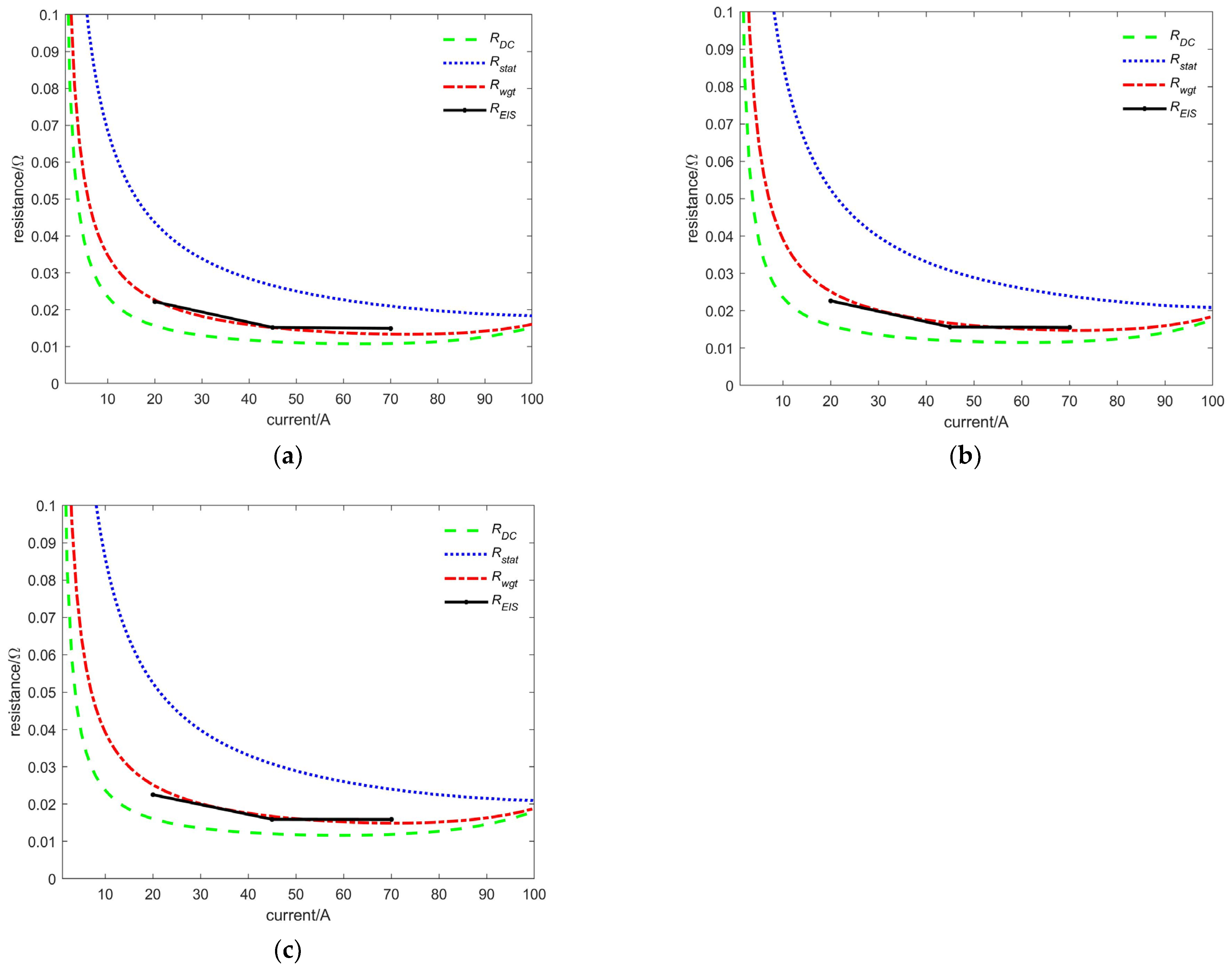Study of Resistance Extraction Methods for Proton Exchange Membrane Fuel Cells Based on Static Resistance Correction
Abstract
:1. Introduction
- (1)
- A method of extracting steady-state resistance is proposed, based on a semi-empirical model of polarization curves, to avoid the complexities of physical model calculation.
- (2)
- Based on the characteristics of the EIS data under different current density conditions, the corresponding ECMs are empirically constructed and the dynamic polarization resistance of the fuel cell stack is calculated accordingly.
- (3)
- A strategy to correct the steady-state resistance using static internal resistance weighting is suggested. This strategy is employed to explain the polarization resistance difference of a fuel cell stack from steady-state to dynamic processes.
2. Description of the Publicly Available Datasets Used for the Study
3. The Semi-Empirical Extraction Method for Dynamic and Static Internal Resistance
4. Dynamic Polarization Resistance Extraction Method Based on ECM
5. Resistance Extraction Results and Discussion
5.1. Relationship between Dynamic and Steady-State Polarization Resistances
5.2. Static Internal Resistance Correction Method
5.3. Analysis and Discussion
6. Conclusions
- Based on the semi-empirical model of the polarization curves, it is possible to obtain the steady-state polarization resistance and the static internal resistance of fuel cell stacks with high accuracy, avoiding the complicated calculation process of physical models.
- By considering the pseudo-inductive effect at ultra-low frequencies and the feed line inductor at high frequencies, it is feasible to design ECMs that align with various current density conditions based on the characteristics of the EIS data. From these ECMs, the dynamic polarization resistance can be extracted.
- Estimating the zero-frequency resistance using leads to a considerable systematic error. The use of an correction strategy based on weighting can markedly decrease the relative error between steady-state and dynamic polarization resistance. The empirical weights utilized could differ depending on the perturbation amplitude of the EIS test and the intrinsic characteristics of the fuel cell stack.
Author Contributions
Funding
Data Availability Statement
Conflicts of Interest
References
- Park, J.; Oh, H.; Ha, T.; Lee, Y.I.; Min, K. A review of the gas diffusion layer in proton exchange membrane fuel cells: Durability and degradation. Appl. Energy 2015, 155, 866–880. [Google Scholar] [CrossRef]
- Mert, S.O.; Dincer, I.; Ozcelik, Z. Performance investigation of a transportation PEM fuel cell system. Int. J. Hydrogen Energy 2011, 37, 623–633. [Google Scholar] [CrossRef]
- Demuren, A.; Edwards, R.L. Modeling Proton Exchange Membrane Fuel Cells—A Review. In 50 Years of CFD in Engineering Sciences; Springer: Singapore, 2020. [Google Scholar]
- Bernay, C.; Marchand, M.; Cassir, M. Prospects of different fuel cell technologies for vehicle application. J. Power Sources 2002, 108, 139–152. [Google Scholar] [CrossRef]
- Olabi, A.G.; Wilberforce, T.; Abdelkareem, M.A. Fuel cell application in the automotive industry and future perspective. Energy 2021, 214, 118955. [Google Scholar] [CrossRef]
- Market Research Future®. Part of WantStats Research and Media Pvt. ‘Hydrogen and Fuel Cells Market Research Report—Forecast to 2025’ ID: MRFR/E&P/4491-CR. May 2018. Available online: https://www.marketresearchfuture.com/reports/hydrogen-fuel-cells-market-5947 (accessed on 1 February 2024).
- Loskutov, A.; Kurkin, A.; Shalukho, A.; Lipuzhin, I.; Bedretdinov, R. Investigation of PEM Fuel Cell Characteristics in Steady and Dynamic Operation Modes. Energies 2022, 15, 6863. [Google Scholar] [CrossRef]
- Tang, Z.; Huang, Q.-A.; Wang, Y.-J.; Zhang, F.; Li, W.; Li, A.; Zhang, L.; Zhang, J. Recent progress in the use of electrochemical impedance spectroscopy for the measurement, monitoring, diagnosis and optimization of proton exchange membrane fuel cell performance. J. Power Sources 2020, 468, 228361. [Google Scholar] [CrossRef]
- Reggiani, U.; Sandrolini, L.; Burbui, G.L.G. Modelling a PEM fuel cell stack with a nonlinear equivalent circuit. J. Power Sources 2007, 165, 224–231. [Google Scholar] [CrossRef]
- Wei, Y.; Zhao, Y.; Yun, H. Estimating PEMFC ohmic internal impedance based on indirect measurements. Energy Sci. Eng. 2021, 9, 1134–1147. [Google Scholar] [CrossRef]
- Danzer, M.A.; Hofer, E.P. Analysis of the electrochemical behaviour of polymer electrolyte fuel cells using simple impedance models. J. Power Sources 2009, 190, 25–33. [Google Scholar] [CrossRef]
- Boillot, M.; Bonnet, C.; Jatroudakis, N.; Carre, P.; Didierjean, S.; Lapicque, F. Effect of Gas Dilution on PEM Fuel Cell Performance and Impedance Response. Fuel Cells 2006, 6, 31–37. [Google Scholar] [CrossRef]
- Cruz-Manzo, S.; Chen, R. A generic electrical circuit for performance analysis of the fuel cell cathode catalyst layer through electrochemical impedance spectroscopy. J. Electroanal. Chem. 2013, 694, 45–55. [Google Scholar] [CrossRef]
- Choi, J.; Sim, J.; Oh, H.; Min, K. Resistance Separation of Polymer Electrolyte Membrane Fuel Cell by Polarization Curve and Electrochemical Impedance Spectroscopy. Energies 2021, 14, 1491. [Google Scholar] [CrossRef]
- Macdonald, D.D. Reflections on the history of electrochemical impedance spectroscopy. Electrochim. Acta 2006, 51, 1376–1388. [Google Scholar] [CrossRef]
- Heinzmann, M.; Weber, A.; Ivers-Tiffee, E. Advanced impedance study of polymer electrolyte membrane single cells by means of distribution of relaxation times. J. Power Sources 2018, 402, 24–33. [Google Scholar] [CrossRef]
- Zhu, D.; Yang, Y.; Pei, F.; Ma, T. High-precision identification of polarization processes of distribution of relaxation times by polarization curve model for proton exchange membrane fuel cell. Energy Convers. Manag. 2022, 268, 115994. [Google Scholar] [CrossRef]
- Thosar, A.U.; Agarwal, H.; Govarthan, S.; Lele, A.K. Comprehensive analytical model for polarization curve of a PEM fuel cell and experimental validation. Chem. Eng. Sci. 2019, 206, 96–117. [Google Scholar] [CrossRef]
- Andronie, A.; Stamatin, I.; Girleanu, V.; Ionescu, V.; Buzbuchi, N. Simplified Mathematical Model for Polarization Curve Validation and Experimental Performance Evaluation of a PEM Fuel Cell System. Procedia Manuf. 2019, 32, 810–819. [Google Scholar] [CrossRef]
- Larminie, J.; Dicks, A.; McDonald, M.S. Fuel Cell Systems Explained, 2nd ed.; Wiley: Hoboken, NJ, USA, 2003. [Google Scholar]
- IEEE PHM Data Challenge. 2014. Available online: https://search-data.ubfc.fr/FR-18008901306731-2021-07-19_IEEE-PHM-Data-Challenge-2014.html (accessed on 1 January 2024).
- Kim, J.; Lee, S.-M.; Srinivasan, S.; Chamberlin, C.E. Modeling of Proton Exchange Membrane Fuel Cell Performance with an Empirical Equation. J. Electrochem. Soc. 1995, 142, 2670–2674. [Google Scholar] [CrossRef]
- Fraser, S.D.; Hacker, V. An empirical fuel cell polarization curve fitting equation for small current densities and no-load operation. J. Appl. Electrochem. 2008, 38, 451–456. [Google Scholar] [CrossRef]
- Li, P.; Tong, X.M.; Hao, D.; Hou, Y.P. Semi-empirical model improving for polarization curve of PEMFC. Battery Bimon. 2015, 45, 179–181. [Google Scholar]
- Niya, S.M.R.; Hoorfar, M. Study of proton exchange membrane fuel cells using electrochemical impedance spectroscopy technique—A review. J. Power Sources 2013, 240, 281–293. [Google Scholar] [CrossRef]
- Fouquet, N.; Doulet, C.; Nouillant, C. Model based PEM fuel cell state-of-health monitoring via ac impedance measurements. J. Power Sources 2006, 159, 905–913. [Google Scholar] [CrossRef]
- Niya, S.M.R.; Hoorfar, M. On a possible physical origin of the constant phase element. Electrochim. Acta 2016, 188, 98–102. [Google Scholar] [CrossRef]
- Wagner, N.; Kaz, T.; Friedrich, K.A. Investigation of electrode composition of polymer fuel cells by electrochemical impedance spectroscopy. Electrochim. Acta 2008, 53, 7475–74827. [Google Scholar] [CrossRef]
- Sun, R.; Xia, Z.; Yang, C.; Jing, F.; Wang, S.; Sun, G. Experimental measurement of proton conductivity and electronic conductivity of membrane electrode assembly for proton exchange membrane fuel cells. Prog. Nat. Sci. 2020, 30, 912–917. [Google Scholar] [CrossRef]
- Yan, X.; Hou, M.; Sun, L.; Liang, D.; Shen, Q.; Xu, H.; Ming, P.; Yi, B. AC impedance characteristics of a 2kW PEM fuel cell stack under different operating conditions and load changes. Int. J. Hydrogen Energy 2007, 32, 4358–4364. [Google Scholar] [CrossRef]
- Ren, P.; Pei, P.; Li, Y.; Wu, Z.; Chen, D.; Huang, S.; Jia, X. Diagnosis of water failures in proton exchange membrane fuel cell with zero-phase ohmic resistance and fixed-low-frequency impedance. Appl. Energy 2019, 239, 785–792. [Google Scholar] [CrossRef]
- Kim, T.; Kim, H.; Ha, J.; Kim, K.; Youn, J.; Jung, J.; Youn, B.D. A degenerated equivalent circuit model and hybrid prediction for state-of-health (SOH) of PEM fuel cell. In Proceedings of the 2014 International Conference on Prognostics and Health Management, Cheney, WA, USA, 22–25 June 2014. [Google Scholar]
- Wagner, N. Characterization of membrane electrode assemblies in polymer electrolyte fuel cells using a.c. impedance spectroscopy. J. Appl. Electrochem. 2002, 32, 859–863. [Google Scholar] [CrossRef]
- Chatenet, M.; Benziger, J.; Inaba, M.; Kjelstrup, S.; Zawodzinski, T.; Raccichini, R. Good practice guide for papers on fuel cells and electrolysis cells for the Journal of Power Sources. J. Power Sources 2020, 451, 227635. [Google Scholar] [CrossRef]
- Pivac, I.; Barbir, F. Inductive phenomena at low frequencies in impedance spectra of proton exchange membrane fuel cells—A review. J. Power Sources 2016, 326, 112–119. [Google Scholar] [CrossRef]
- Schiefer, A.; Heinzmann, M.; Weber, A. Inductive Low-Frequency Processes in PEMFC-Impedance Spectra. Fuel Cells 2020, 20, 499–506. [Google Scholar] [CrossRef]
- Huang, S.Y.; Ganesan, P.; Popov, B.N. Development of conducting polypyrrole as corrosion-resistant catalyst support for polymer electrolyte membrane fuel cell (PEMFC) application. Appl. Catal. B Environ. 2009, 93, 75–81. [Google Scholar] [CrossRef]
- Lv, B.; Han, K.; Li, X.; Wang, X. Study and Experimental Verification of the Effect of Assembly Pressure on the Electrical Efficiency of PEM Fuel Cells. In Proceedings of the 5th International Conference on Energy Storage and Intelligent Vehicles (ICEIV 2022), Beijing, China, 3–4 December 2022; Sun, F., Yang, Q., Dahlquist, E., Xiong, R., Eds.; ICEIV 2022; Lecture Notes in Electrical Engineering; Springer: Singapore, 2023; Volume 1016. [Google Scholar] [CrossRef]








Disclaimer/Publisher’s Note: The statements, opinions and data contained in all publications are solely those of the individual author(s) and contributor(s) and not of MDPI and/or the editor(s). MDPI and/or the editor(s) disclaim responsibility for any injury to people or property resulting from any ideas, methods, instructions or products referred to in the content. |
© 2024 by the authors. Licensee MDPI, Basel, Switzerland. This article is an open access article distributed under the terms and conditions of the Creative Commons Attribution (CC BY) license (https://creativecommons.org/licenses/by/4.0/).
Share and Cite
Mao, Y.; Hou, Y.; Gu, R.; Hao, D.; Yang, Q. Study of Resistance Extraction Methods for Proton Exchange Membrane Fuel Cells Based on Static Resistance Correction. World Electr. Veh. J. 2024, 15, 179. https://doi.org/10.3390/wevj15050179
Mao Y, Hou Y, Gu R, Hao D, Yang Q. Study of Resistance Extraction Methods for Proton Exchange Membrane Fuel Cells Based on Static Resistance Correction. World Electric Vehicle Journal. 2024; 15(5):179. https://doi.org/10.3390/wevj15050179
Chicago/Turabian StyleMao, Yuzheng, Yongping Hou, Rongxin Gu, Dong Hao, and Qirui Yang. 2024. "Study of Resistance Extraction Methods for Proton Exchange Membrane Fuel Cells Based on Static Resistance Correction" World Electric Vehicle Journal 15, no. 5: 179. https://doi.org/10.3390/wevj15050179






